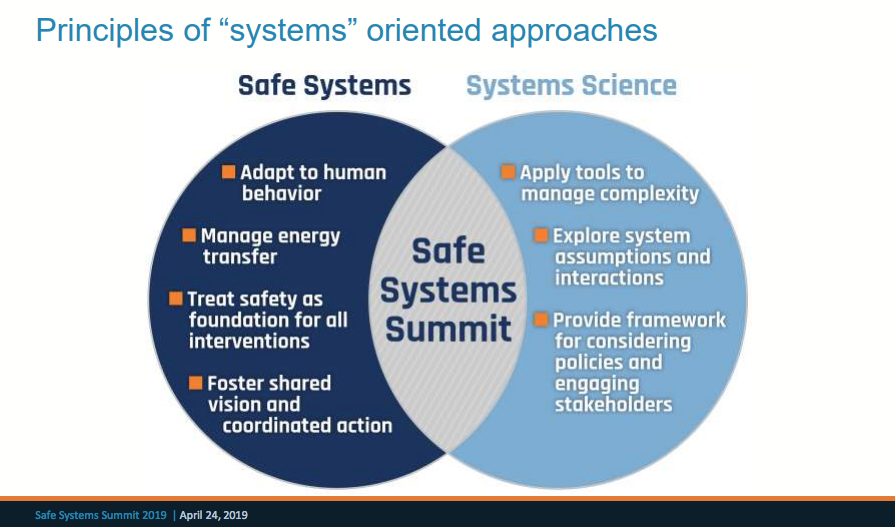According to the latest data from the National Highway Traffic Safety Administration (NHTSA), there were 37,133 traffic fatalities on U.S. roadways in 2017, a 1.8-percent decrease from the 37,806 people killed in 2016. While there has been a general downward trend downward in traffic fatalities overall, this is still an alarmingly high number of deaths – and there have been troubling increases for vulnerable road users like pedestrians. A new report from the Governors Highway Safety Association (GHSA) projects that 6,227 pedestrian fatalities occurred in 2018 – an alarming figure, as it is the highest number in nearly 30 years.

2019 Safe Systems Summit, Durham, NC
A Fresh Approach to Road Safety
Clearly there is more work to be done and an urgent need to take a different approach to advancing road safety and public health. This was the aim of the inaugural 2019 “Safe Systems Summit: Redefining Transportation Safety” held on April 23-24, 2019 in Durham, North Carolina and hosted by the Collaborative Sciences Center for Road Safety (CSCRS), a National University Transportation Center led by the UNC Highway Safety Research Center at the University of North Carolina, Chapel Hill. The Center unites leading university transportation research, planning, public health, data science and engineering programs with the mission to create and exchange knowledge to advance transportation safety through a multidisciplinary, Safe Systems approach.
The UC Berkeley team, led by SafeTREC Co-Director Offer Grembek, is one of four university consortium members, along with Duke University, Florida Atlantic University and University of Tennessee, Knoxville.
What is a Safe System?
The purpose of the Summit was to provide an opportunity to explore the Safe Systems approach and what it means for the U.S. as a whole, as well as for states, communities, and individuals.

As defined by the CSCRS, “A core tenet of this approach is that even though road users make mistakes, these mistakes should not result in death, so the model envisions a roadway system designed to prevent death despite human errors. This perspective also acknowledges that a safe system requires a specific method focusing on the built environment and a proactive approach to address risk.” The idea is that even a momentary lapse in judgement on the road, something that any of us can have, should not result in a permanent tragedy.
Moving Safe Systems Principles into Practice
What does moving the principles of a safe systems approach into practice look like? UC Berkeley SafeTREC Co-Director and CSCRS Associate Director Offer Grembek led a session on Tuesday, April 23, 2019 at the Safe Systems Summit to explore this question and showcase examples from projects and communities that are incorporating Safe Systems principles, and practical methods to integrate roadway design, community engagement and other considerations. Speakers included Jill Cooper, SafeTREC Co-Director, and Sarah Garner, Traffic Safety Resource Prosecutor with the North Carolina Conference of District Attorneys.

Sarah Garner, Offer Grembek, Jill Cooper, 2019 Safe Systems Summit
Grembek opened the session with an overview of the Safe Systems approach and stated that “to develop a safe transportation system, it is necessary to effectively harness all of the core protective opportunities provided by the system. This mostly includes coordinated efforts across Safer Roads, Safer Vehicles, and Safer Speeds with considerations about the human tolerance to physical force as the critical constraint.” He also added that “the expectations from road users are limited to being alert and compliant travelers, and that the system should aspire to safely contain any undesirable events caused by user misjudgment.”
Jill Cooper then presented, “Community-driven Safe Systems Planning: Experience from an Outreach Program in California.” She talked about what communities have to teach traffic safety professionals about safe systems. Professionals can look at the collision and injury data and point to historical problems, and this is important, but communities know which streets have broken sidewalks, or speeding drivers, or lack of crosswalks. Cooper noted that “Communities understand their roadways and barriers to safety, as well as opportunities for partnerships to improve safety and well-being.”
Sarah Garner wrapped up the session with a presentation on her work as a North Carolina Traffic Safety Resource Prosecutor. Garner's work is focused more on education and legal sanctions for road users who demonstrate a limited ability to operate vehicles as alert and compliant travelers. As part of her presentation, Ms. Garner presented a set of programs to encourage behavior modification across various platforms.
The Road Ahead
Our current transportation system is complex and there are many challenging safety issues yet to be solved. There are also many promising real-world practices, tools and systems-oriented approaches that we, as a learning community, can embrace to fundamentally change our roadways so they are safe for all. A final closing thought from the Summit reinforces this and the fact that we all have a role to play: Let’s rethink safety, not as a property of places, objects and individuals, but as a community resource.
